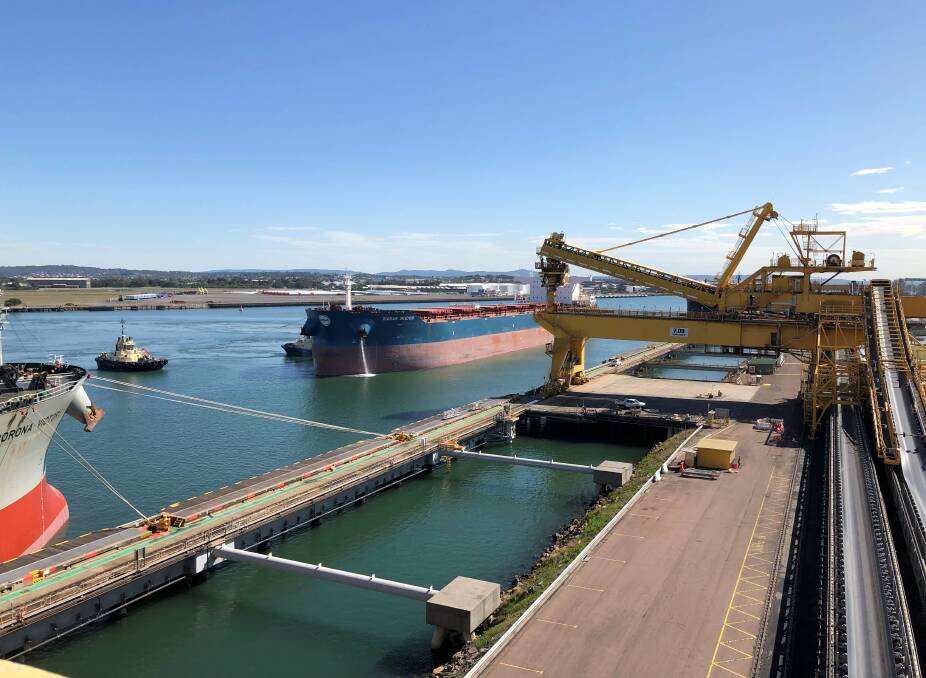
Port Waratah Coal Services had a "significant increase" in coal throughput last year to loading 111.3 million tonnes of coal onto 1279 ships, it's second-biggest year ever, the company said on Friday.
Subscribe now for unlimited access.
$0/
(min cost $0)
or signup to continue reading
The 111.3 million tonnes for 2021 was 5 per cent up on the COVID-impacted 105.9 million tonnes loaded into 1192 ships in 2020.
Last year's 1279 vessels was a record, brought about by a change in customers during the year that saw smaller ships arriving in the port.
The coal throughput was only 600,000 tonnes less than the company's biggest year in 2014, which saw 111.9 million tonnes loaded onto 1228 ships.
In 2019, PWCS shipped 110.6 million tonnes, a 3 per cent increase on 2018, in 1226 ships.
IN THE NEWS:
PWCS chief executive Hennie du Plooy said it was the 10th consecutive year of exports exceeding 100 million tonnes.
Mr du Plooy said he was satisfied with the operational achievement but saw 2021 as a year marked by "volatility and change".
"We recognise that Port Waratah's unique role in the Hunter Valley coal chain requires us to perform consistently and reliably, in the interest of both producing and end-user customers," Mr du Plooy said.
"Despite the challenges presented by COVID-19, adverse weather conditions and significant market changes, our teams were able to deliver strong performance in the year."
PWCS operates the Carrington Coal Terminal and the older and larger of two loaders on Kooragang Island.
The other Kooragang loader is run by Newcastle Coal Infrastructure Group, which lost one of its two shiploaders for part of the year through storm damage, and moved an unofficial 46 million tonnes as a result.
Mr du Plooy said that despite "limited exports to China" - the result of an unofficial ban on Australian coal that began in late 2019 - the overall demand for Hunter Valley coal remained strong, with that demand "reflected quickly in price increases" that began in late 2020 and peaked in October this year.
Australian Coal Report marked the high point of the market on October 15, with a price for spot - or one-off cargoes - at $US254 a tonne ($338 a tonne at the exchange rate of $0.75 at the time).
The market had bottomed in August 2020 at $US46.50 ($68.50 at $0.72 at the time) and had settled back to $US160 ($223) before Christmas.
"Our experience indicates that demand for our region's coal remains stable and aligned with the International Energy Agency's predictions that global demand for coal will be stable through to 2024," Mr du Plooy said.
"Half of all coal handled by PWCS was destined for the Hunter Valley's core market in Japan, and our records indicate that exports increased into countries such as Taiwan, India and Thailand.
"Some of these changes presented challenges for our operations, such as a significant increase in the number of smaller-sized vessels we were required to load, highlighting the importance of the Carrington terminal, for which we were able to secure a lease extension during the year."
Mr du Plooy said the Hunter Valley Coal Chain had a "collaborative nature", which contributed to "the overall success of the industry".
"The coal chain remains a complex beast, and we couldn't do what we do without the collaboration of producers, rail haulage providers, the Port Authority of NSW, the Port of Newcastle and the large number of service providers that play a role in keeping the coal flowing," Mr du Plooy said.
"All parties had to deal with significant uncertainty and the challenges presented once again by the pandemic, so I want to thank and congratulate everyone on the achievement of again bringing high-quality Hunter Valley coal to the world reliably and consistently."
Mr du Plooy said PWCS remained focus on "sustainably delivering the service its customers expect, in a way that meets community expectations".
Previous annual reports show PWCS exporting 107 million tonnes in 2018, in 1229 ships.
In 2017, it was 104.6 million tonnes on 1198 ships, which was 4.4 per cent down on the 2016 result of 109.5 million tonnes in 1225 ships.
In 2015, the total was 108.9 million tonnes in 1193 ships, which was 2.7 per cent down on the 111.9 million tonnes in 2014, the all-time record, into 1228 ships.
In 2013, a then-record 109.2 million tonnes went into 1193 ships, up 3.1 per cent on the 2012 figure of 105.8 million tonnes, the first time PWCS broke the 100-million-tonne barrier.
The T4 loader proposed for Kooragang was on the books at the time, before being formally abandoned in 2018.
In 2011, the tonnages totalled 97.8 million tonnes, in 1025 ships, which was 2.9 per cent up on the 94.9 million tonnes shipped in 2010.
The 2009 total was 92.8 million tonnes, up on 91.4 million tonnes in 2008.

Our journalists work hard to provide local, up-to-date news to the community. This is how you can continue to access our trusted content:
- Bookmark: newcastleherald.com.au
- Download our app
- Make sure you are signed up for our breaking and regular headlines newsletters
- Follow us on Twitter
- Follow us on Instagram
- Follow us on Google News


